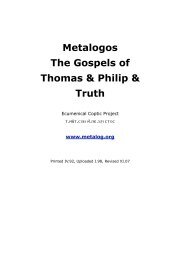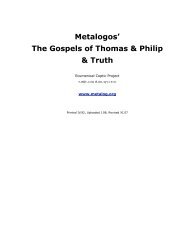Andrew Louth - Syriac Christian Church
Andrew Louth - Syriac Christian Church
Andrew Louth - Syriac Christian Church
You also want an ePaper? Increase the reach of your titles
YUMPU automatically turns print PDFs into web optimized ePapers that Google loves.
NOTES 209<br />
111 Diamonê, taxis, thesis, kinêsis: cf. Nemesius, On human nature 42<br />
(Morani [1987], 120, l.25–121, l.2), though Nemesius has phora instead<br />
of kinêsis: see Amb. 10.35 (1176BC), above.<br />
112 The definitions of providence are taken directly from Nemesius, On<br />
human nature 42 (Morani [1987], 125, ll. 4–8); they also appear in John<br />
Damascene, Exposition of the Faith 43, ll. 2–6 (Kotter [1973], 100).<br />
113 Byzantines distinguished between the ‘outer’ and the ‘inner’ learning:<br />
the ‘outer learning’ was pagan philosophy—either classical or late<br />
antique—the ‘inner learning’ was <strong>Christian</strong> theology. The distinction is<br />
mainly polemical, since both inner and outer learning were indebted to<br />
Greek philosophy, esp. Plato and the Neoplatonists. For a discussion of<br />
this distinction in the later Byzantine period, see D.M.Nicol, <strong>Church</strong><br />
and Society in the Last Centuries of Byzantium (Cambridge: Cambridge<br />
University Press, 1979), chapter 2. Those who limit providence are<br />
principally the followers of Aristotle (see n. 114, below). The idea that<br />
providence is limited to the realm above the moon was popularized in<br />
the influential treatise On the world, ascribed to Aristotle.<br />
114 A view regularly ascribed to Aristotle in late antiquity and the Byzantine<br />
period. Nemesius (on whom Maximus is drawing) discusses Aristotle’s<br />
views on providence in On human nature 43 (Morani [1987], 127ff.)<br />
115 As Nemesius says: On human nature 43 (Morani [1987], 130, ll. 7–10).<br />
Maximus has modified Nemesius’ first reason.<br />
116 A Stoic idea, that became a commonplace in much late ancient<br />
philosophy.<br />
117 This sentence is very close to Nemesius, On human nature 43 (Morani<br />
118 Another sentence drawn directly from Nemesius, On human nature 43<br />
(Morani [1987], 133, ll. 2–5).<br />
119 Maximus now returns to the text from Gregory Nazianzen’s sermon to<br />
discuss the final phrase about passing beyond the material dyad.<br />
Gregory uses this imagery in other sermons, notably Sermon 23.4, which<br />
is the subject of other Ambigua: Arab. 23, from the early set, and from<br />
the later set, Amb. 1, translated below.<br />
120 This notion of a Trinitarian image of God in man—which is reminiscent<br />
of Augustine (see On the Trinity 9–10)—is derived from Gregory<br />
Nazianzen (Sermon 23.11; PG 35:1161C) and found elsewhere in<br />
Maximus (e.g. Quaestiones et dubia 105: Declerck [1982], 80), who<br />
bequeathed it to John Damascene (Exposition of the Faith 26: Kotter<br />
[1973], 76. In Byzantine theology it never attained the influence that<br />
Augustine’s conception exercised in Western medieval theology.<br />
121 Most of this chapter is a précis of Nemesius, On human nature 15–22<br />
(Morani [1987], 72–82): Maximus begins with chapter 22. The material<br />
appears again, in a form that is indebted to Nemesius, independently of<br />
whatever debt it owes to Maximus, in John Damascene, Exposition of<br />
the Faith, 26–30 (Kotter [1987], 75–83).<br />
122 Literally: is not ‘within us’ (en hêmin), an important category in<br />
Maximus’ ethics. It occurs, too, in Nemesius, On human nature 26<br />
(Morani [1987], 87, l. 22], whose normal expression is, however, eph’




